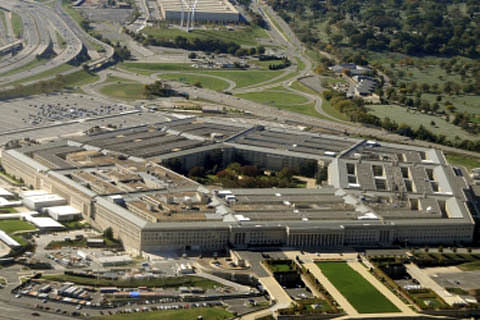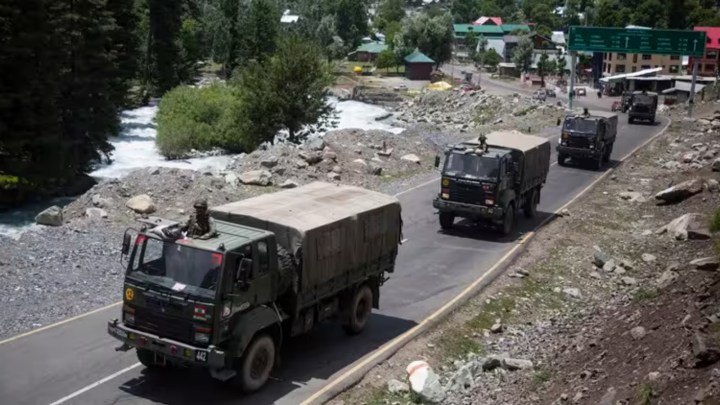
Following Galwan clashes, China ramped up troop presence, infra along LAC in 2022, says Pentagon
No progress in talks so far, both sides fear losing perceived advantage: Report
Written by Amrita Nayak DuttaUpdated: October 22, 2023 08:51 IST

An Indian army convoy moves on the Srinagar- Ladakh highway at Gagangeer, north-east of Srinagar, India, Wednesday, June 17, 2020. (AP Photo)
Listen to this article
00:00
China has maintained constant military presence while boosting infrastructure at the Line of Actual Control (LAC) since the June 2020 clashes between Chinese and Indian troops in Ladakh’s Galwan Valley, according to a Pentagon report that offers crucial insights into Beijing’s growing military capabilities and activities in the region.
In its latest annual report to the U.S. Congress, the Department of Defense said there was an increased deployment of Chinese troops along the LAC in 2022. The deployments will likely continue through 2023, it said.
The details come as India and China prepare for their fourth consecutive winter at the LAC in eastern Ladakh since the start of the Ladakh standoff. The 20th round of military talks between the two sides earlier this month failed to yield any substantive forward movement.
As reported earlier by The Indian Express, the Indian Army, as part of its winter posture in the region, is planning an overall redeployment of troops along the LAC while maintaining a strong domination using the latest surveillance devices and helicopters.
The LAC is divided into three sectors: the eastern sector, which spans Arunachal Pradesh and Sikkim; the central sector in Uttarakhand and Himachal Pradesh, and the western sector in Ladakh.
According to the Pentagon report, the Chinese deployment in the western sector of LAC includes one border regiment supported by two divisions of the Xinjiang and the Tibet Military Districts, with four combined arms brigades (CAB) in reserve.
Three light-to-medium CABs have been brought into the eastern sector from other theatre commands, while three additional CABs have been deployed in the central sector, the report said.
Following Galwan clashes, China ramped up troop presence, infra along LAC in 2022, says Pentagon
No progress in talks so far, both sides fear losing perceived advantage: Report
Written by Amrita Nayak DuttaUpdated: October 22, 2023 08:51 IST

An Indian army convoy moves on the Srinagar- Ladakh highway at Gagangeer, north-east of Srinagar, India, Wednesday, June 17, 2020. (AP Photo)
Listen to this article
00:00
China has maintained constant military presence while boosting infrastructure at the Line of Actual Control (LAC) since the June 2020 clashes between Chinese and Indian troops in Ladakh’s Galwan Valley, according to a Pentagon report that offers crucial insights into Beijing’s growing military capabilities and activities in the region.
In its latest annual report to the U.S. Congress, the Department of Defense said there was an increased deployment of Chinese troops along the LAC in 2022. The deployments will likely continue through 2023, it said.
The details come as India and China prepare for their fourth consecutive winter at the LAC in eastern Ladakh since the start of the Ladakh standoff. The 20th round of military talks between the two sides earlier this month failed to yield any substantive forward movement.
As reported earlier by The Indian Express, the Indian Army, as part of its winter posture in the region, is planning an overall redeployment of troops along the LAC while maintaining a strong domination using the latest surveillance devices and helicopters.
The LAC is divided into three sectors: the eastern sector, which spans Arunachal Pradesh and Sikkim; the central sector in Uttarakhand and Himachal Pradesh, and the western sector in Ladakh.
 According to the Pentagon report, the Chinese deployment in the western sector of LAC includes one border regiment supported by two divisions of the Xinjiang and the Tibet Military Districts, with four combined arms brigades (CAB) in reserve.
According to the Pentagon report, the Chinese deployment in the western sector of LAC includes one border regiment supported by two divisions of the Xinjiang and the Tibet Military Districts, with four combined arms brigades (CAB) in reserve.
Three light-to-medium CABs have been brought into the eastern sector from other theatre commands, while three additional CABs have been deployed in the central sector, the report said.
“Although some elements of a light CAB eventually withdrew, a majority of the deployed forces remained in place along the LAC,” it added. A CAB integrates various arms including artillery, infantry, armoured and others to jointly fight a battle.
The report also said that in 2020, after the Galwan clashes, China deployed the PLA’s Special Operations Forces (SOF) from its Tibet Military Region, even though the SOF units “lacked real-world combat experience.”
On infrastructure buildup along the LAC through 2022, the report said China has built underground storage facilities near Doklam (where Indian and Chinese soldiers faced off in June 2017 after Chinese Army tried to build a road), while new roads have been built in all three sectors of the LAC. It also mentions new villages in the disputed areas in Bhutan, besides a second bridge over the Pangong Lake (Ladakh), besides a dual-purpose airport and multiple helipads.
The report said that while India and China have held multiple rounds of military and diplomatic talks to resolve the issues along the LAC in the last three years, with some amount of disengagement achieved at four friction points, overall progress has been minimal as both sides resisted losing perceived advantages on the border.
“In addition to continued PLA deployments at the LAC on the Indian border, the PLA conducted multiple “around the clock” large-scale exercises in training areas throughout the country to include joint operations in response to the US and Taiwan actions in 2022,” it added.
Flagging China’s advancement efforts to evolve into a world class military”, the report said the PLA is aggressively developing capabilities to provide options for Beijing to “dissuade, deter, or, if ordered, defeat” third-party intervention in the Indo-Pacific region, and to conduct operations deeper in this region as well as globally
China, with an overall defence budget of $229 billion, has also sought to improve its proficiency as a joint force to conduct the full range of “land, air, and maritime as well as nuclear, space, counterspace, electronic warfare (EW), and cyberspace operations”, the report said. Beijing, it said, demonstrated its new long-range fire capability in the PLA’s response (China had launched extensive military drills) after the August 2022 US Congressional Delegation (CODEL) visit to Taiwan.
According to the report, in 2022, the People’s Liberation Army Navy (PLAN), the largest navy in the world with an overall battle force of over 370 ships and submarines and more than 140 major surface combatants, launched its third aircraft carrier, CV-18 Fujian.



